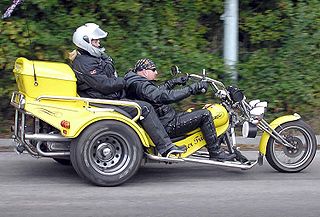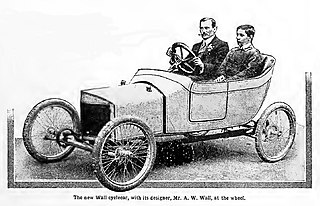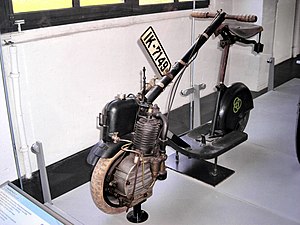
A feet first (FF) motorcycle is a class of motorcycle design which positions the rider with their feet ahead, like a car, rather than below and astride, as with conventional bikes. As there are other types of motorcycle that have a 'feet forward' position, an alternative term sometimes used is advanced single track vehicle. The name "feet first" was first used by Royce Creasey.

A minibike is a two-wheeled, motorized, off-highway recreational vehicle popularized in the 1960s and 1970s, but available continuously from a wide variety of manufacturers since 1959. Their off-highway nature and typically entirely off-road legal status differentiate minibikes from motorcycles and mopeds, and their miniature size differentiates them from dirt bikes.

A preselector gearbox is a type of manual transmission mostly used on passenger cars and racing cars in the 1930s, in buses from 1940–1960 and in armoured vehicles from the 1930s to the 1970s. The defining characteristic of a preselector gearbox is that the gear shift lever allowed the driver to "pre-select" the next gear, usually with the transmission remaining in the current gear until the driver pressed the "gear change pedal" at the desired time.

Phelon & Moore manufactured motorcycles in Cleckheaton, Yorkshire, England from 1904 to 1967, particularly those under the Panther marque. They became identified with a design of motorcycle which had a large sloping 40-degree single-cylinder engine as a stressed member of the frame. This design spanned the entire history of the company, starting with a 500 cc model and ending with a 645 cc model.

In the market, there is a wide variety of types of motorcycles, each with unique characteristics and features. Models vary according to the specific needs of each user, such as standard, cruiser, touring, sports, off-road, dual-purpose, scooters, etc. Often, some hybrid types like sport touring are considered as an additional category.

Cushman is a manufacturer of industrial, personal, and custom vehicles. It is based in Augusta, Georgia, United States, and is owned by Textron.

The Caldwell Vale Truck & Bus Co. was an Australian automobile, bus, truck and tractor manufacturer from 1907 to 1913 in the Sydney suburb of Auburn. The company started in 1907 when Felix Caldwell and Norman Laurie Caldwell of South Australia filed for a patent covering "Improvements in and connected with driving and steering motor propelled vehicles". In short, the patent was for a four-wheel-drive system with four-wheel-steering. Later they combined with Henry Vale of New South Wales and in 1910, the trio applied for a patent covering "Improved power steering gear for heavy motor driven road vehicles". Few technical details have survived about the marque and roughly 40 examples of the vehicles appear to have been made. A touring car, it is known to have had four-wheel drive, a 30 hp six-cylinder engine and four-wheel steering. The company also built a fair tractors. In 1912–13, the company lost a court case to do with the performance guarantee of the trucks and was taken over by Purcell Engineering in 1916.

Douglas was a British motorcycle manufacturer from 1907 to 1957 based in Kingswood, Bristol, owned by the Douglas family, and especially known for its horizontally opposed twin cylinder engined bikes and as manufacturers of speedway machines. The company also built a range of cars between 1913 and 1922.

Differential steering is the means of steering a land vehicle by applying more drive torque to one side of the vehicle than the other. Differential steering is the primary means of steering tracked vehicles, such as tanks and bulldozers, is also used in certain wheeled vehicles commonly known as skid-steer, and even implemented in some automobiles, where it is called torque vectoring, to augment steering by changing wheel direction relative to the vehicle. Differential steering is distinct from torque steer, which is usually considered a negative side effect of drive-train design choices.
Motorcycle components and systems for a motorcycle are engineered, manufactured, and assembled in order to produce motorcycle models with the desired performance, aesthetics, and cost. The key components of modern motorcycles are presented below.
Blackburne was a trade name of Burney and Blackburne Limited a British manufacturer of motorcycles from 1913 to 1922 at Tongham near Farnham, Surrey. They were also a major supplier of engines to other motor cycle and light car makers and continued to make these until 1937. Burney and Blackburne also made small aircraft engines.

ABC motorcycles was a British motorcycle manufacturer established in 1914 by Ronald Charteris in London. Several British motorcycle firms started up with the name "ABC", including Sopwith. The All British Engine Company Ltd. of London was founded in 1912 and later changed to ABC Motors Ltd. With chief engineer Granville Bradshaw, Charteris built a range of engines throughout the First World War. From 1913 ABC produced motorcycle engines.

Quadrant was one of the earliest British motorcycle manufacturers, established in Birmingham in 1901. Famous for their big singles, Quadrant pioneered many innovations that proved important for motorcycle development but struggled after the First World War and the company was wound up in 1928.

The Corgi Motorcycle Co Ltd. was a British motorcycle manufacturer based in Southport that produced 98 cc scooters developed by managing director John Dolphin from the military Welbike motorcycle. Production of the Corgi scooter for the UK market began in 1948 and 27,050 were manufactured before production ended in October 1954.

A scooter is a motorcycle with an underbone or step-through frame, a seat, a transmission that shifts without the operator having to operate a clutch lever, a platform for their feet, and with a method of operation that emphasizes comfort and fuel economy. Elements of scooter design were present in some of the earliest motorcycles, and motor scooters have been made since at least 1914. More recently, scooters have evolved to include scooters exceeding 250cc classified as Maxi-scooters.

The Maico Mobil is an early touring motorcycle made by Maico between 1950 and 1958. Conceived and marketed as a “car on two wheels”, the Mobil had body panels that enclosed the drivetrain, protected its riders from the elements, and included an integral pair of panniers and a mount for a spare tyre.

A motorized tricycle, motor trike, or motortrycle is a three-wheeled vehicle based on the same technology as a motorcycle, and powered by an electric motor, motorcycle, scooter or car engine.

The Honda NC700 series is a family of motorcycles produced by Honda since 2012. NC700 series was a 'new concept', being unlike conventional motorcycles, a bike designed for commuters, new or veteran riders. The series also includes the motorcycle/scooter hybrid NC700D Integra. The NC700 series is classed as a commuter model bike which has incorporated design and mechanical elements from various motorcycle types. The riding position is similar to standard bike styles. There is a helmet-sized internal storage in place of the traditional fuel tank, which in turn is located under the seat. The series is often marketed as fun to ride, easy to handle and very fuel efficient.

The Honda C92 Benly is a 125 cc (7.6 cu in) parallel-twin motorcycle made by Honda from 1959 through 1965. Running concurrently were the CB92 Sports and the slightly larger C95 150 cc (9.2 cu in), called the CA92 and CA95 in the US. These twins took their styling and design cues from the larger-displacement Honda C71, C76, C72, C77 Dream series.

Arthur William Wall was an engineer in the field of motorised transport and inventor of the self-powered wheel in England in the early 20th century. He is best known for his creation of the self-powered wheel, the Wall Autowheel, which could be used to power a bicycle, but he was also the man behind Roc motorcycles and a tricar and four-wheel cyclecar. His main company was A. W. Wall Ltd, but he created several other companies to compartmentalise his different activities, such as the Roc Gear Co, who supplied epicyclic gears to a significant number of manufacturers before WW1.





















